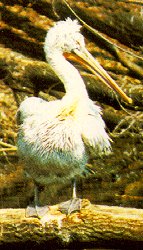 Synonyms: None
Synonyms: NonePelecanus crispus Bruch., 1832
 Synonyms: None
Synonyms: None
Common names: Bulg: Cadroglav pelican; Engl: Dalmatian pelican; Rom: Pelican chet; Russ: Kudryavy pelikan; Turk: Tepeli pelikani; Ukr: Kucheryavy pelikan
Order: PELECANIFORMES
Family: PELECANIDAE
Taxonomic descriptions: WB - occurs during migration and in summer in the Danube Delta and on the surrounding lakes. The first breeding attempt was recorded in 1985 in the Kugurlui lake (3 pairs). NB - a rare vagrant to the "Chernomorski" reserve. CB - single birds and small groups are recorded throughout the year, but not annually. NA - vagrants were recorded near the town of Berdiansk. BS - Romania, Bulgaria.
 IUCN
Status:
IUCN
Status:
World level: VU
Black Sea Regional level: VU
Subregion level: VU (Ukraine sector)
Distribution:
Habitats type, Critical habitats, Limiting factors: Preferably large waterbodies with old reed-beds and lots of fish, but occurs also in bays and islets with poor vegetation. Breeding habitats include hardly accessible lakes in estuarine areas. Eutrophication, causing destruction of the environment, changes in the salinity balance, falls in fish productivity, wetland transformation and disturbance.
Biology: Only a few pairs breed in Ukraine on Kugurlui lake in the Odessa region. Wintering grounds are located in the Danube delta area, but the flocks appearing there at the end of March compared with the White Pelican are much smaller. Breeds in small colonies. Both birds take part in the building of the nest which is made of reeds and lined with grass and moss. The most frequent are floating nests near the open water. The clutch, varying from 1 to 6, usually consists of 2-4 eggs, and is incubated mostly by the female for 33-40 days. As a typical ichtyophagi Dalmatian Pelicans are often accompanied by White Pelicans. Small groups of pelicans can catch fish at various depth. By September their number decreases and almost all the pelicans leave the area by the end of the month. 28.10.52 is the latest record (town of Berdiansk, the Sea of Azov). Winter grounds are situated in Iraq, Iran, Pakistan and NW India.
Population trends: In the past the breeding range of the Dalmatian Pelican included the entire coast of the southern Europe. By the end of the XIX century it had disappeared from the low reaches of all the Black Sea rivers. A sharp decrease was recorded throughout by the beginning of the XX century. Current population size (the Danube delta) is small, but stable. In other sub-regions of the Black Sea coast it remains a vagrant.
Threats: Eutrophication, causing destruction of the environment, changes in the salinity balance, decrease in fish numbers.
Conservation measures taken: The species is protected in the "Dunaiskie Plavni" reserve.
Conservation measures proposed: Strengthening of protection in the reserve and creation of its own section on Kugurlui lake (the only breeding site of the Dalmatian Pelican in Ukraine).
References:
Compiled by: T.Ardamatzkaia